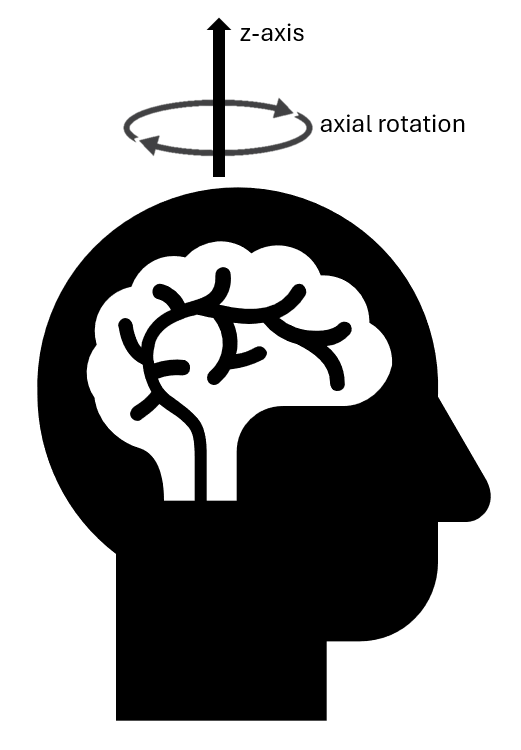Neck Axial Moment
Overview
Neck axial moment represents the rotational force exerted onto the z-axis of the neck (see figure below) [1]. This moment can result in severe injuries like soft tissue strains, herniated discs, or cervical ligament damage [1]. This moment usually reaches a maximum value during periods of rapid head/neck accelerations [1]. If the ATD used in testing has an established Injury Assessment Reference Value (IARV), the peak axial moment is reported as a percentage of that IARV to indicate potential injury severity [2]. The IARV represents the a threshold value used to evaluate the risk of injury during an impact, each ATD has their own IARV value depending on the type, sex, and size of the dummy [2].

Required Signals
- Moment of the Upper or Lower Neck (Z)
Calculation
- The neck axial moment (moment at the z axis) is filtered at CFC = 600.
- Signal is truncated to start at 0 seconds (only applicable if signal has moment values before time = 0 seconds)
- Finds the maximum axial moment and the corresponding time it occured
- Calculates the percent of the IARV that the calculated maximum axial neck moment reaches
Neck Axial Moment IARV Table [3]
| ATD | IARV - in position tests (Nmm) | IARV - out of position tests (Nmm) |
|---|---|---|
| CRABI – 6mo | 13 | 10 |
| CRABI – 12mo | 14 | 11 |
| CRABI – 18mo | 15 | 12 |
| HIII – 3yo | 21 | 17 |
| HIII – 6yo | 30 | 24 |
| HIII – 10yo | 40 | 32 |
| HIII – F05 | 49 | 39 |
| HIII – M50 | 97 | 78 |
| HIII – M95 | 128 | 103 |
| SID-II | 49 | 39 |
| BioSID | 97 | 78 |
In position testing refers to crash testing where the ATD is properly seated and restrained, similar to a typical driving scenario [4]. Out of position testing refers to crash testing where the ATD may be in a non-seated posture or have shifted from their seat [4].
References
[1] Ivancic PC. Biomechanics of sports-induced axial-compression injuries of the neck. J Athl Train. 2012 Sep-Oct;47(5):489-97. doi: 10.4085/1062-6050-47.4.06. PMID: 23068585; PMCID: PMC3465029.
[2] Merkle AC., Kleinberger M., Uy OM. "The Effects of Head-Supported Mass on the Risk of Neck Injury in Army Personal". Johns Hopkins University Applied Physics Laboratory, Volume 26, Number 1 (2005).
[3] Yoganandan, Narayan, et al. "Accidental Injury". Biomechanics and Prevention, 3rd edition. Springer, 2020.
[4] "Guidlines for Using the UMTRI ATD Positioning for ATD and Seat Positioning (Version I)". Insurance Institute for Highway Safety, January 2003.